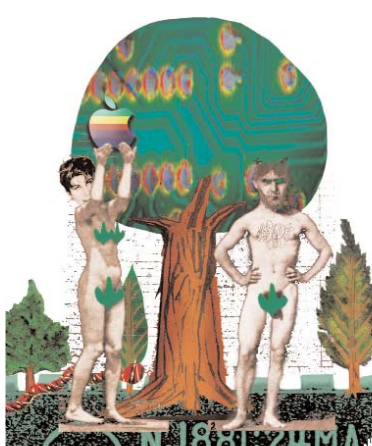"Consuming Passions": James de Givenchy
For me there’s nothing like jewellery to produce lust and provoke desire. I can’t help it. I look at James de Givenchy’s stuff and I want to hold it, wear it, possess it. Call it obsession. Call it the female urge to decorate. It’s not about the price; it’s not about validation; it’s not about some kind of post-feminist notion that you don’t need a man to get you the bijoux . (I’m told that many new divorcees buy jewels to make themselves feel better.) I don’t care how I get them; I just want them and, at the moment, it’s James de Givenchy who has my heart. They call him the new JAR , the new Verdura, the new Andrew Grima. He is, in fact, the singular James de Givenchy who, if he works in the tradition of those great master jewellers, has his own style. His jewels are big, voluptuous, joyous, full of colour, life and wit. They look as good from the back as the front. (Wish I did!) He is also very handsome. And nice. Here is a French guy whose uncle is the great couturier Hubert de Givenchy; here is a guy with the accent and the French blue eyes, the style, the je ne sais quoi . But he’s also a New Yorker, accessible, funny, unimpressed by pretension. Go up the stairs to his showroom off Madison Avenue (his company is called Taffin), and he’s there trying not to eat the chocolates he’ll offer you with an espresso. He has a kind of impulsive genius. James de Givenchy saw a coral tree at a fair in Basel; it was used to hang other pieces on. He bought the whole tree. “Probably old Italian coral,” he says. He sliced it up; the result is a necklace of huge, heavy, intensely pink slices of coral set in gold. And there’s the 19th-century Roman micro-mosaic, a brooch made of tiny tiles fashioned of stone, in this case into a pattern with birds and trees. Givenchy framed the piece in variously sized, emerald cut little diamonds to reflect the shapes of the tiles, and surrounded it with red spinels to pick up on the cherries in the trees; the back is constructed out of gold bricks. All this drama, all this theatre for only $54,000. I could be just as happy with a pair of his rose quartz earrings for less than 10 grand, though. I could be happy with the necklace of garnets and peridots, the tumbled stones like something out of a magic dryer. Or the huge turquoise beads, one strand a robin’s egg blue to break your heart; the other the hottest, purest turquoise, the essence of turquoise, complete turquoisity. A string of either, fastened with a diamond or sapphire clasp, is $40,000, but who’s counting? You can’t get Persian turquoise any more; it’s not on the Ayatollah’s export list. Most of the rest comes from Arizona’s Sleeping Beauty Mine. It’s not the same. I’m telling you, looking at gems with James is a lesson in geo-politics. Bright, big, yummy as candy-coloured stones have been around for a long time, of course; everyone mixes it up. You see diamonds with slabs of wood; you see “organic” shapes; every street corner boasts a jeweller who knows more about coloured tourmalines than is good for a person. But James de Givenchy does it more wildly, more wittily, more extravagantly. Earrings like flowers feature rare demantoid garnets in a surreal green colour for the purist. There is a 28-carat spinel ring, the centre stone surrounded by tiny moonstones shaped like, well, tiny moonstones. A necklace is hung with Burmese peridots cut almost flat and surrounded by Ceylon sapphires. I’m not sure if the terms are PC, but who cares? For the insecure groom to be, there’s even a Tie the Knot band made in the ficelle style that Givenchy invented; it’s a thin band of diamonds. Then he can let her decide if she wants a boring old diamond solitaire for the engagement ring or if she wants a black opal ring set in tiny stones that match the colours of the opal-green garnets, Montana sapphires, the kind L ouis Comfort Tiffany discovered. If you were asking me, I’d rather have the big sapphire surrounded by other little sapphires, just like bridesmaids, in blue, green, pink and pale yellow. It’s $65,000, but money doesn’t matter when you’re in the grip. I have to lie down now; the fever is rising.
|
 Again,
I’m obsessed. It’s the grisly month of November, winter coming
on, the days dwindling down, and I’m in the grip of a have to
have: I want James de Givenchy’s lime citrines. Each one is big
as a fruit and the colour of lemon-lime Jell-O or quivering key
lime pie or just-licked lollipops; strung on a couple of thin
twisted gold wires that look too fragile to hold them, the biggest
stone is 250 carats. But it holds, centre and all. (I’m not just
a shopper girl, OK? I mean, I can allude to Yeats.)
Again,
I’m obsessed. It’s the grisly month of November, winter coming
on, the days dwindling down, and I’m in the grip of a have to
have: I want James de Givenchy’s lime citrines. Each one is big
as a fruit and the colour of lemon-lime Jell-O or quivering key
lime pie or just-licked lollipops; strung on a couple of thin
twisted gold wires that look too fragile to hold them, the biggest
stone is 250 carats. But it holds, centre and all. (I’m not just
a shopper girl, OK? I mean, I can allude to Yeats.) 


